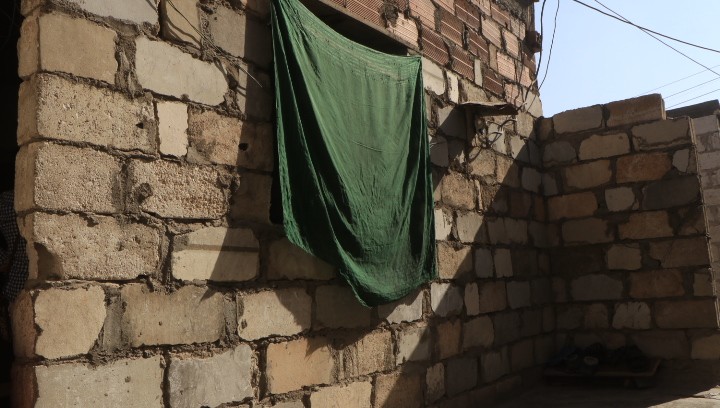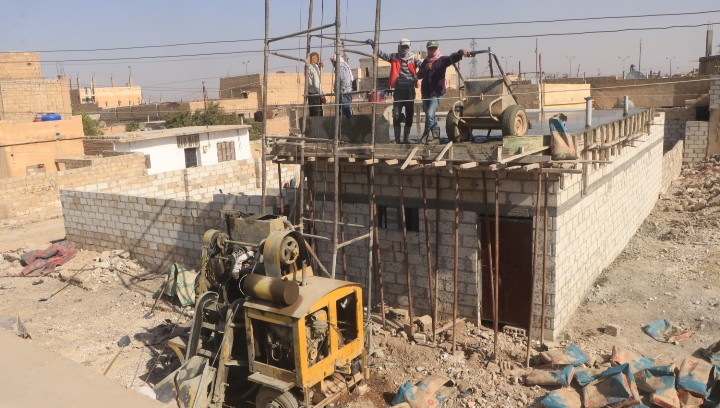Nearly 2 years after IS prison attack, no compensation for owners of demolished Hasakah homes
Dozens of homes surrounding the al-Sinaa prison in Hasakah city were demolished in the wake of a major Islamic State attack in January 2022. Nearly two years later, homeowners have not been compensated despite AANES promises.
4 December 2023
HASAKAH — As winter approaches, Anwar al-Abdullah, 35, is busy pouring a concrete roof for two rooms he built on the ruins of his destroyed house near al-Sinaa prison in Syria’s northeastern Hasakah city. He went into debt to pay for the work, borrowing 15 million Syrian pounds ($1,090).
Nearly two years have passed since the Islamic State (IS) attacked al-Sinaa prison, one kilometer from al-Abdullah’s home, in January 2022, aiming to break hundreds of IS prisoners out of the Syrian Democratic Forces (SDF)-run facility. During battles that ensued, scores of homes in the area around the prison were damaged or destroyed—including al-Abdullah’s four-room house.
When the fighting ended, al-Abdullah and other impacted Hasakah residents lived in the hope of receiving compensation, “even if partial,” from the SDF-backed Autonomous Administration of North and East Syria (AANES), which administers the area. In April 2022, AANES officials promised to work towards compensating them, but so far “nobody has compensated us,” he told Syria Direct.
As months became years, al-Abdullah’s hope dried up. Finally, he decided this year to erect two simple rooms amid the debris of what he lost in Hasakah’s Ghweiran neighborhood.
During the 2022 IS attack, fighters infiltrated “the Ghweiran, al-Nashwa and al-Zuhour neighborhoods, as well as the Faculty of Economics building adjacent to the prison” in the south of Hasakah city, according to the SDF. Several days of fierce clashes erupted, before the SDF announced it foiled the attack on January 30. Some 374 IS fighters were reportedly killed in the battles, in addition to 121 SDF fighters and prison workers. Four civilians were also killed.
Al-Abdullah was one of thousands of people who fled the area of the fighting during the IS attack. When they returned, they were shocked at the scale of the destruction: Some of their homes were razed to the ground, while others were partially destroyed.
At first, many organizations and bodies came to inspect damage in the area, but “people were coming to use us to ask for money and leave,” al-Abdullah said sarcastically, implying the visits were only aimed at taking pictures and documenting the damage.
Al-Abdullah refrained from mentioning who was responsible for destroying his home. However, Human Rights Watch has accused the SDF of destroying or damaging at least 140 private buildings housing 147 families in January and February 2022 while repelling the IS attack and pursuing fighters. A number of local residents told Syria Direct the same.
The AANES holds IS responsible for the damage, saying last year that the attack led to the destruction of 120 houses in the Ghweiran and al-Zuhour neighborhoods. Of these, 62 were completely destroyed and 58 partially destroyed, according to the de facto governing body.
However, a statement by Nowruz Ahmad, a member of the SDF’s general command, on January 31, 2022, that tunnels dug by IS cells ran under houses in the two neighborhoods, aligns with what residents told Syria Direct: That, citing the existence of tunnels, the SDF brought in machinery to demolish their homes.
Syria Direct attempted to contact the AANES-affiliated co-presidency of Hasakah for comment on damages in the vicinity of al-Sinaa prison, as well as promises made to compensate affected homeowners, but received no response as of the time of publication.
Abandoned
Nearly two years after the al-Sinaa attack, some impacted Hasakah residents have received food baskets from the regime-linked Syrian Arab Red Crescent (SARC). Others have received sums of SYP 350,000-450,000 ($25-30) per family from a Norwegian organization on two or three occasions, a number of affected homeowners told Syria Direct.
Al-Abdullah has not received any money, but even if he had, “what does SYP 450,000 pay for,” he wondered. He built his destroyed 225-square-meter house for around SYP 95 million ($6,900), while the cost of building two rooms on its rubble was around SYP 30 million ($2,181).
As al-Abdullah spoke, his mother, Zahra al-Abdullah, 55, interjected: “We returned after 15 days of displacement to find the house destroyed. Look, they left one room to live in,” she said.
With their home destroyed, at first the family rented a house for SYP 250,000 ($18.20) per month. It was a great deal of money for al-Abdullah, the head of the family, who works as a motorcycle taxi driver. He decided to build two rooms to save on the monthly rent.
Al-Abdullah built the rooms five months ago, and the family lived in them throughout this past summer. “For four months, we’ve been sleeping in these rooms without a roof, because we couldn’t afford the cost of pouring it. We used blankets to block the sun,” he said. But with winter looming, “I had to go into debt for the roof,” he added.
Walking through the Ghweiran neighborhood, Syria Direct noted that some residents have completely or partially rebuilt their homes, while others are still rubble. Former residents rent homes in the same neighborhood or others nearby, because they cannot afford to rebuild.
Umm Ali, 65, pays SYP 300,000 ($21.80) a month to rent a house for her, her two married sons and their children. She lost her four-room home during the IS attack last year.
“Our house is leveled. The home of a lifetime is gone,” she said. Sighing, she continued: “Many people came and took pictures of our house, but we haven’t received any compensation. We want them to compensate us, but if they do not, we leave it to their conscience.”
“We aren’t able to buy a single block [brick],” Umm Ali told Syria Direct, eyeing piles of debris that were once her home. She cannot “even remove the rubble.”
Who owes compensation?
The al-Sinaa prison lies within the SDF-backed AANES’ areas of influence, and civilians accuse the former of demolishing dozens of homes near the prison in the wake of the January 2022 IS attack. Under Article 164 of the Syrian Civil Code, “any person who commits an error that causes injury to others shall be liable to pay compensation,” and the AANES is the authority responsible for administering the area.
The AANES bears responsibility “based on tort liability and security control,” Shahin Lali, a lawyer based in Hasakah’s Qamishli, told Syria Direct. “On the other hand, if the AANES relies on the theory of emergencies and force majeure, it is not obligated to provide compensation,” he added, describing the case as “thorny.”
A second lawyer, who spoke to Syria Direct on condition of anonymity for security reasons, agreed that the issue of compensation for homes destroyed following the IS attack is thorny, since “international coalition forces were part of the operation.” Furthermore, “AANES laws do not address incidents like the al-Sinaa prison attack and its fallout,” he added.
“The AANES is not able to provide compensation, due to its financial crisis. It has still not paid for wheat purchased from farmers, although months have gone by since it received the crop,” he said. “Begging international and local organizations could be a better way to compensate those impacted,” in his view.
Rule 150 of customary international humanitarian law holds that “a state responsible for violations of international humanitarian law is required to make full reparation for the loss or injury caused.” Here, compensation is “not [only] for states, but includes individuals too,” Seifa Izoli, a professor of international law based in Paris, told Syria Direct.
“The contemporary rules of international humanitarian law oblige states to provide compensation and reparation for damages caused to individuals, and enable them to directly claim reparation from the responsible state,” Izoli said. However, the AANES is not an internationally recognized government, which makes applying these rules a point of contention.
“The Syrian Democratic Forces have yet to fully and publicly explain why they needed to destroy dozens of homes to capture the prison attackers and secure the area,” Gerry Simpson, associate crisis and conflict director at Human Rights Watch, said in the organization’s 2022 report. He stressed the need to “help affected families rebuild their lives.”
Since al-Sinaa prison—also called Ghweiran prison after the neighborhood where it is located—is under AANES control, the administration “is responsible for compensating those affected, not the Syrian regime,” Izoli said.
There are three ways to claim compensation or reparations, all difficult tasks for affected residents. The first two are “for individuals to submit requests directly to national courts, or claim compensation from the United Nations Compensation Commission [UNCC], but this requires a resolution from the Security Council,” she said. The third is to make a “claim through the International Criminal Court, especially when war crimes amount to crimes against humanity.”
Izoli advised impacted families to set up an association to speak in their name and demand their rights, as was done by the families of victims of the 2015 Paris attacks, who “established an association that speaks in their name and carries out all the procedures, and also appointed a lawyer to defend their rights and demand compensation from the French state.”
Since the SDF is backed by the international coalition, the latter could be asked to support the AANES with funds needed to compensate affected homeowners in the area of the al-Sinaa prison, Izoli said.
Fadia Basili, 43, and her neighbor Manar Hussein, 24, do not know how to go to court to obtain compensation for their damaged houses. Nor they do not trust that this step would succeed in granting them their right to compensation. Instead, they have relied on members of their families to restore their destroyed houses, using the original bricks, they told Syria Direct.
Sitting with her neighbors near her destroyed house, Basili counted what she lost in the al-Sinaa attack. “The house went, with all that was in it. A huge loss: the rooms, utilities, refrigerator, kitchen utensils—all gone,” she said. “When we came back, the whole house was demolished,” she added, breaking into tears. “We got SYP 450,000 [$30] from an organization…not enough to buy a refrigerator!”
Basili borrowed money from relatives to rebuild a single room on the ruins of her destroyed home. She used “recycled bricks from the rubble to rebuild the wall of the house,” building it by hand with her daughters.

The wall of Fadia Basili’s house in the Ghweiran neighborhood of Hasakah city, which she built with her daughters using recycled bricks from the rubble of her destroyed home, 30/10/2023 (Salam Ali/Syria Direct)
The stories of those impacted by events surrounding the al-Sinaa prison attack are similar, and their pain is shared. Passing through neighborhoods near the prison, one sees what was once their homes: heaps of rubble, sitting unchanged for nearly two years.
With no compensation, residents find what solutions they can. Salma Ahmad (a pseudonym), 35, lost her five-room house. “We can’t afford to rebuild the house, so we made do with building two rooms, after borrowing money from my brother-in-law,” she said. Relatives provided “blankets and mattresses, because we couldn’t afford to furnish the house,” she added.
Residents like Ahmad and al-Abdullah are rebuilding what they can. But as they pick up the pieces of their shattered homes in the shadow of the prison, they live with the fear that al-Sinaa could see another attack, and that they could lose everything again—with no compensation.
This investigation was produced with financial support from the European Endowment for Democracy (EED). Syria Direct is solely responsible for its contents, which do not necessarily reflect the views of EED. It was originally published in Arabic and translated into English by Mateo Nelson.







